31 Oct 2016 - {{hitsCtrl.values.hits}}

Your customers have more needs and wants than you are presently satisfying. What are they and  what do you have to do to satisfy them and reposition your business?
what do you have to do to satisfy them and reposition your business?
For example, Amazon started as an online bookseller. The company built an amazing system to categorize and track what its individual customers ordered so it could suggest other titles of interest. Once it had its customers hooked on the look and feel of its service, Amazon began expanding into other categories of interest to its customers such as music, electronics and apparel.
Rather than do all of the work itself, Amazon partners with other companies to warehouse and deliver its products. But everything is sold through Amazon’s website, which now is close to being a one-stop shop for virtually all of its customers’ needs.
Yet, there can be misfires, too. Companies can go too far in search of this strategy. For example, Starbucks started as a premium American coffee company with a coffeehouse chain. Then it added snacks, CDs, books and other non-essential items that cluttered the counters and made its stores less inviting. In 2009, Starbucks kicked off a major effort to get back to its roots. In this case, trying to sell more resulted in selling less.
Review portfolio
The consumers’ buying habits reflect their personality, income, age, lifestyle and aspirations. What people want to buy can change over the years. Many consumers constantly seek out new products that meet their changing needs more closely. This is particularly true whenever consumers pursue the pleasures of food. To grow their business profitably, companies must constantly review their product portfolio. Marketers and product developers must use their understanding of consumer behaviour to satisfy changing consumer needs. This is true even for industrial giants with brands that are household names.
In this essay, we are going to take Heinz as an example to clarify certain points. Heinz has a series of icon products that are brand leaders and with which the company is closely associated, like salad cream, baked beans, tomato ketchup, etc. However, Heinz knows that it cannot afford to rely simply on the existing strength of these icon products, so the company has created an innovative culture focused upon consumer needs in order to encourage the development of new ideas.
If you study the company’s history, you will note how the popularity of Heinz’s core icon products has been maintained and enhanced, by developing aspects of the product or brand, to keep them relevant and satisfying for modern consumers. It also covers innovations introduced by Heinz in order to stay ahead of the competition and bring new consumers to the Heinz brand.
Review product mix
The product mix is the complete range of products produced by a company. When managing a large range of products serving several markets, firms must develop ways of analysing the performance of these products.
Changes in consumer tastes mean that even though certain products may have staying power, there is always a demand for new products. In such a situation, refreshing the existing concepts through innovation will extend the way in which products are used and consumed.
Gap filling
Firms need to use their knowledge of their market to (1) identify gaps and trends in the existing and new markets and (2) develop creative ideas.
Gap filling products include innovative product extensions that match the changing consumer needs. For example, many companies offer an optional organic product or range which co-exists alongside their mainstream lines. For example, Heinz products are sold within the fast-moving consumer goods markets. Today these markets are characterised by (1) intense competitive activity, (2) innovative and creative products and (3) rapidly changing markets reflecting different lifestyle/expectations.
For example, within these markets, many of today’s consumers do not want to spend time cooking. They want (1) products that are convenient and can be effortlessly cooked, (2) a broader range of product options with more choices to meet their needs, tastes and lifestyles, (3) convenient packaging that enables products to be eaten direct from the microwave, (4) products that do not create any washing up and (5) products that can be eaten on the move.
Over and above these generic qualities, many consumers want the reassurance that comes from superior quality associated with a brand heritage. Heinz, for example, was very careful to keep up their image and be well placed to meet this requirement.
Review product development
New product development is a sequential process of finding ideas for new goods, turning those ideas into commercially viable additions, replacements or extensions to the existing product lines. Heinz knows that the innovation process depends on generating a stream of new ideas. These can come from various sources, e.g., from consumer feedback, employees, in-house brainstorming sessions and market research. By encouraging these new ideas, Heinz begins to focus on those which meet consumers’ needs and are practical for the market place.
The key functions of any pack are to provide the consumer with a functional concept that protects its contents in transit, storage and use. These requirements play an important part in determining the shape and size of the packaging and also the materials used. Packaging (1) attracts potential consumers, (2) communicates information and (3) creatively identifies and unifies products as part of a range or brand, (e.g. Heinz Tomato Ketchup).
Heinz is accustomed to using new technologies to keep its products in line with the changing consumer needs, such as ring pulls on cans or plastic and foil packaging, etc. The consumer buying habits reveal that they want foods that can be cooked conveniently and quickly. Through its microwaveable formats, Heinz is using packaging to add value to its existing product portfolio in a way that has enabled the company to meet a whole new range of consumer requirements.
For example, Heinz baked beans have come out of the can and into a microwaveable pot too. Over 90 percent of people have access to a microwave at work and the number of households owning microwaves has increased by 50 percent in the last 10 years. Not surprisingly, product development is concentrating on convenience and speed without loss of taste or quality.
Consider creative partnerships
Successful firms are always looking for creative partnerships that offer benefits to all parties. Heinz also did the same. It recently joined forces with Walkers (British snack food manufacturer) to launch a range of six flavours celebrating the British sandwich culture. Each flavour incorporates a sauce from Heinz. This partnership enabled Heinz to extend out of its traditional markets.
To serve fast-moving consumer goods markets within an ever-increasing fragmented media environment, firms need to set up a mix of communication routes that have the ability to reach specific target audiences.
For example, as a core icon product, Heinz Salad Cream became relevant to a whole new generation of consumers following its relaunch a few years ago. A range of quirky 30-second TV commercials were created to support Heinz Salad Cream, in which Heinz is depicted as the gold standard in salad creams in a humorous and memorable way – “There is only one salad cream worth tasting and that’s Heinz Salad Cream Vintage 1914!”
Through new ideas, constant innovation and development of its core icon brands, Heinz is able to stay at the forefront of its markets. By responding to the changing needs of consumers, Heinz has achieved a high level of consumer satisfaction. Heinz continues to enjoy the benefits of (1) high levels of brand awareness and customer loyalty, (2) an enlarged customer base with a constant demand for products and (3) high levels of customer confidence, which encourages support of new and existing Heinz products even when faced with new offerings from rival producers.
(Lionel Wijesiri is a retired corporate director counting three decades of senior management experience. He is now an independent consultant and a freelance journalist. He may be contacted on [email protected])
10 Jan 2025 42 minute ago
10 Jan 2025 47 minute ago
10 Jan 2025 2 hours ago
10 Jan 2025 2 hours ago
10 Jan 2025 2 hours ago